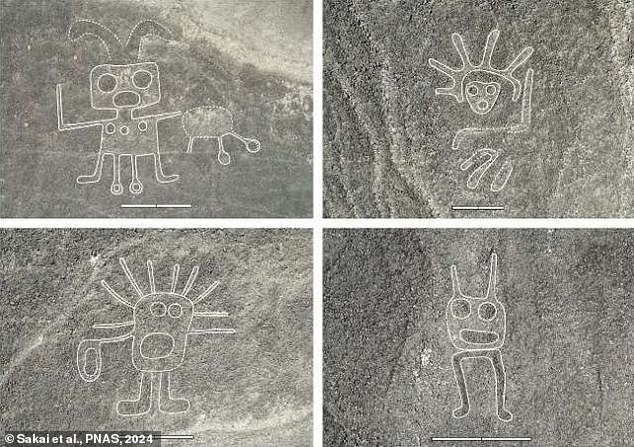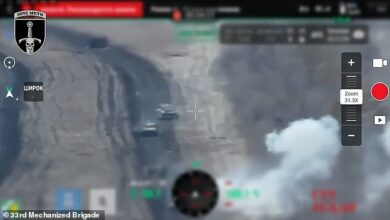More than 300 mysterious Nazca symbols have been discovered in Peru, including a Wall-E-style figure, alien figures and killer whales with KNIVES

For nearly 100 years, scientists have been amazed by the famous Nazca geoglyphs: ancient patterns in the soil of the Nazca Desert in southern Peru.
Thanks to artificial intelligence, researchers have now discovered another 303 drawings. They are probably the most bizarre yet.
These include alien figures, orcas with knives, cats, camels and a figure that resembles Pixar’s Wall-E robot.
Photographs show some new discoveries, with lines added by hand to emphasize the original lines, which have been blurred by erosion.
The mysterious Nazca markings may date back to 400 BC, but scientists still aren’t sure what their function was, if any.

More than 300 mysterious Nazca symbols have been discovered in Peru, including a Wall-E-style figure (top left) and alien figures

The true purpose of the mysterious Nazca Lines has long puzzled archaeologists. Pictured: Orcas with knives
The 303 new discoveries have been detailed by a group of researchers from Yamagata University in Japan and the IBM Thomas J Watson Research Center in New York in the Proceedings of the National Academy of Sciences.
“It took nearly a century to discover a total of 430 figurative Nazca geoglyphs, which provide important insights into the ancient cultures of the Nazca Pampa,” the team said in their paper.
‘Here we report on the deployment of an AI system across the Nazca region, a UNESCO World Heritage site, leading to the discovery of 303 new figurative geoglyphs in just six months of field research.’
The researchers scanned aerial photographs of the Peruvian site using IBM’s artificial intelligence, because the technique can identify landmarks in the landscape that the human eye would otherwise miss.
Of the 303 newly discovered geoglyphs, 178 were individually suggested by the AI, which was trained to look for them in drone photos.
They mainly depict wild animals, such as orcas and tame camels, and human motifs, including alien humanoids.
There are also some primate pairs playing together, including a pair with large tails holding balls, and a cat with a surprised expression.
Many of the photos simply defy categorization, but show various distorted forms of the human body, including a head with spiky hair and another head on a pair of legs.

They mainly depict wild animals and human motifs, including hominids and domesticated camels

Many of them simply defy categorization, but appear to show various distorted forms of the human figure, including a head with pointed hair and another head on a pair of legs

The Nazca Lines are a group of geoglyphs – large motifs carved into the ground – located in the Nazca Desert in southern Peru
However, the true function of the mysterious Nazca Lines has long remained a mystery to archaeologists.
Some believe they were intended as a kind of observatory, to mark the places where the sun and other celestial bodies rose or set during the solstices.
Other theories hold that they were made to be seen by the gods in the sky, but they may also have simply been artistic expressions, much like the ones we see today.
Often a geoglyph is too large to see from the ground. Only when you are high enough in the air can you make out the shapes of some of the drawings.
Therefore, the details of many designs only became fully understood when the airplane was invented and the works of art could be seen from the air.

Released photos show some of the new discoveries, with manually added lines on the images to emphasize the original lines, which have been blurred by erosion

Pictured: A Homer Simpson-style human Nazca geoglyph previously found by the researchers

A spider geoglyph at Nazca. The figure is said to be 150 feet long and consists of one continuous line
The Nazca Lines were first spotted in 1939, when a pilot flew over the Nazca Plains in the highlands of Peru’s coast. However, it is likely that locals had spotted them on the hilltops much earlier.
Contrary to the common belief that the figures can only be seen from the air, many of them are also visible from the surrounding hills.
According to experts, IBM’s AI could lead to the discovery of even more geoglyphs – possibly thousands.
“AI may be on the verge of revolutionizing archaeological discovery, just as aerial photography has done in the field,” they write in their paper.




